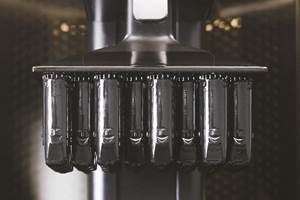3D Systems Adds Figure 4 Tough Clear, DuraForm Pax Black to Materials Portfolio
The two offerings are production-grade materials designed to address a breadth of industrial applications.
Share
Parts produced using Figure 4 Tough Clear are built to last and avoid yellowing or discoloration. Photo Credit: 3D Systems
3D Systems has expanded its material portfolio with the addition of Figure 4 Tough Clear and DuraForm PAx Black — two new production-grade materials designed to address a breadth of industrial applications. Both materials have been engineered for long-lasting mechanical performance and stability in almost any environment, making them well suited for a variety of end-use applications in industries such as consumer goods, transportation and motorsports, aerospace and defense, and service bureaus.
Figure 4 Tough Clear enables direct production of end-use parts. The company says it is the first clear material for its Figure 4 platform which is designed for long-term use parts and functional prototypes. Parts produced using the materials possess excellent clarity that is improved with postprocessing. This characteristic can be extremely valuable for applications such as fluid and gas flow to observe the inner workings of complex assemblies. It can also enhance light transmission and reflection for lenses, light guides and lighting covers. Additionally, this material delivers a desirable combination of customer-critical performance traits, including impact strength, tensile strength and elongation properties which remain stable up to eight years.
Figure 4 Tough Clear is tested to eight years of indoor and one-and-a-half years outdoor mechanical performance per ASTM D4329 and ASTM G154 methods, ensuring that printed parts remain functional and stable for long periods in real-world conditions. In addition to lenses, light guides and lighting covers, this material is well suited for a variety high-volume, small-part applications such as load-bearing handles, cranks, knobs and levers, structural brackets, snap-fits and fasteners, and consumer goods packaging.
“3D printing is the most cost-effective method to produce clear parts, and with the introduction of Figure 4 Tough Clear, we’re giving our customers a path to reduce their time to market,” says Dr. Edwin Hortelano, senior vice president, materials engineering and development, 3D Systems. “Our Figure 4 platform is easy-to-use and facilitates ultrafast production.”
DuraForm PAx Black is said to offer material properties rivaling injection molding. It is the latest offering in 3D Systems’ new open material portfolio for use with selective laser sintering (SLS) printers. This material possesses properties similar to injection-molded plastics and features high impact resistance with high elongation at break in any direction.
DuraForm PAx Black is designed to be used with any commercially-available selective laser sintering (SLS) printer, regardless of the manufacturer, facilitating ease of integration into existing production workflows. This material’s mechanical properties facilitate manufacturing of tough, lightweight, production-grade parts for applications such as orthotics, tooling handles, splints and braces, ducting in rugged environments, living hinges, liquid reservoirs and enclosures requiring high impact and high toughness.
The DuraForm PAx Black’s properties include low temperature printing (for example, 120°C) facilitates efficiencies in printing and postprocessing. The company says it also has impressive long-term stability ratings of over five years indoor for mechanical properties and color. Using vapor honing to postprocess parts moves the elongation at yield capability past that of other nylon materials (such as PA-11 and PA-12), and delivers a shiny, smooth finish nearly indistinguishable from injection-molded parts. It also offers high reuse rates (a 30% refresh rate is recommended), helps reduce waste and decrease production costs.
- Learn about 3D Systems and Ems-Griltech combining their knowledge to produce DuraForm PAx Natural, a material available for all selective laser sintering platforms.
- Read about 3D Systems’ partnership with AMT to work on an industrial-scale selective laser sintering solution that includes the SLS 380.
Related Content
What Does Additive Manufacturing Readiness Look Like?
The promise of distributed manufacturing is alluring, but to get there AM first needs to master scale production. GKN Additive’s Michigan facility illustrates what the journey might look like.
Read MoreAM 101: Digital Light Synthesis (DLS)
Digital Light Synthesis (DLS) is the name for Carbon's resin-based 3D printing process. How it works and how it differs from stereolithography.
Read MoreAircraft Ducts 3D Printed in Composite Instead of Metal: The Cool Parts Show #68
Eaton’s new reinforced PEKK, tailored to aircraft applications, provides a cheaper and faster way to make ducts compared to formed aluminum.
Read MoreThis Drone Bird with 3D Printed Parts Mimics a Peregrine Falcon: The Cool Parts Show #66
The Drone Bird Company has developed aircraft that mimic birds of prey to scare off problem birds. The drones feature 3D printed fuselages made by Parts on Demand from ALM materials.
Read MoreRead Next
3D Printing Brings Sustainability, Accessibility to Glass Manufacturing
Australian startup Maple Glass Printing has developed a process for extruding glass into artwork, lab implements and architectural elements. Along the way, the company has also found more efficient ways of recycling this material.
Read More4 Ways the Education and Training Challenge Is Different for Additive Manufacturing
The advance of additive manufacturing means we need more professionals educated in AM technology.
Read MoreHybrid Additive Manufacturing Machine Tools Continue to Make Gains (Includes Video)
The hybrid machine tool is an idea that continues to advance. Two important developments of recent years expand the possibilities for this platform.
Read More











.png;maxWidth=300;quality=90)












